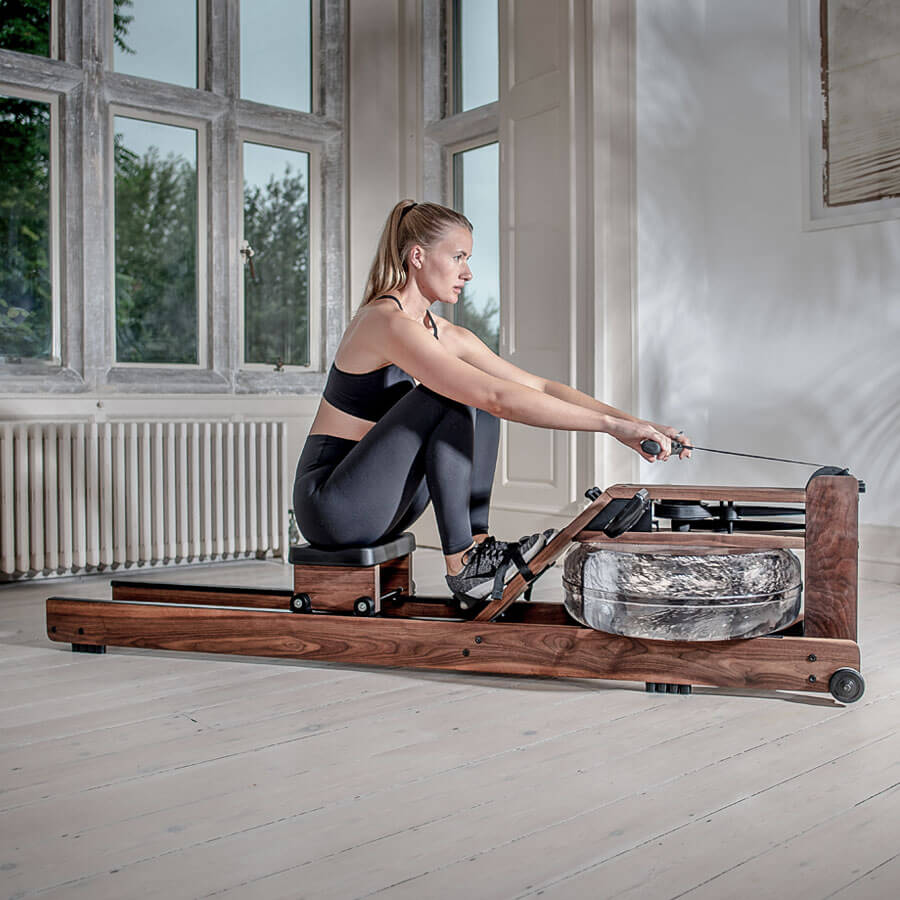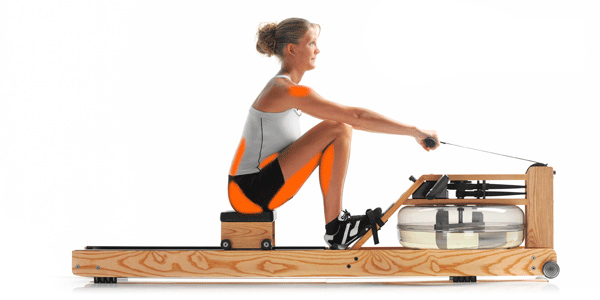TOTAL BODY WORKOUT
Discover the rowing advantage

Whether you’re a seasoned athlete or a fitness enthusiast looking for a powerful indoor training method that will deliver exceptional results: training on the WaterRower will check all the boxes! Indoor rowing provides a total-body workout that targets multiple muscle groups simultaneously for an extremely efficient, time-saving training session. Rowing is a low-impact form of exercise, minimizing stress on your joints while still giving you an intense cardiovascular workout.

BENIFITS OF WATER RESISTANCE
LOW IMPACT
The smooth and consistent resistance provided by water ensures a low-impact yet highly effective workout. This means reduced strain on your joints, making the WaterRower suitable for individuals of all ages and fitness backgrounds. You can train with confidence, knowing that the water resistance will support your movements and provide a challenging, yet joint-friendly workout.

ENGAGE 84% OF YOUR MUSCLES
FULL-BODY WORKOUT
Unlock a full-body workout when training on the WaterRower. Major muscle groups are activated and strengthened while you row. Legs: When you push off from the footrest, this drive generates power and propels you backward. Core: Your core muscles, including the abdominal muscles, obliques, and lower back, play a crucial role in stabilizing your body during rowing. They help you maintain proper posture, balance, and alignment, providing a solid foundation for efficient rowing. Back: The pulling motion engages several muscles in your back, working together to control your motion. Arms & Shoulders: As you pull the handle toward your chest, your arm and shoulder muscles come into action, enhancing upper body strength and definition.
ROWING TECHNIQUE
The Art of Rowing
Whether you’re a novice or an experienced rower, here are some simple tools to help you perfect technique and maximize performance: Rowing is more than just pulling on a handle. It’s a harmonious blend of power, precision, and fluidity: proper technique is key! Your aim is to create a fluid and efficient motion, going through phases, such as the “catch” or “drive” positions, or “release” and “recovery”. The phases create a continuous cycle, forming a rhythmic and coordinated motion of the rowing stroke. Achieving an effective and efficient rowing stroke allows the rower to optimize power output, engage multiple muscle groups, and reach a smooth, flowing rowing motion.
After the .finish*, the rower releases the handle and fully extends the arms. Upper body remains slightly forward-leaning, and legs begin to bend, moving the seat back to the starting position.
During this phase, the rower returns to the starting position. Upper body remains slightly forward-leaning, legs are bent, and the seat moves forward Hands approach the chest, preparing far the next 'catch'
The rower prepares for the Catch. Legs remain bent, upper body is slightly forward-leaning, and the hands move doser to the chest, ready to grip the handle.
This is the starting position of the rowing stroke, with the rower at the front of the machine Legs are bent, upper body is upright, and hands hold the handle at chest height.
In this phase, the rower generates power by pushing off with the legs against the resistance, driving the seat backward Hands remain stationary- mitially-while the leg and core musdes work together to drive the body backward.
Here, legs are fully extended, upper tody leans slightly backward, and hands pull the handle towards the upper abdomen or lower chest, creating a strong connection. This phase emphasizes the culmination of power and completion of the rowing stroke.
ENGAGE YOUR MUSCLES
Synchronise Your Movements

Rowing training delivers a multitude of health benefits. You can count on performing over 50 varying moves per minute! It promotes muscle strength and endurance, improves cardiovascular fitness, enhances core stability and posture, and provides a full-body workout that targets various muscle groups simultaneously.
Strengthen the following areas and joints with rowing exercise:
- Arms
- Shoulders
- Overall core
- Lower back
- Hips
- Legs
- Knees & ankles

Rowing training truly hits the bullseye of exercise options by offering a comprehensive, efficient, and enjoyable workout experience. It’s a winning combination of full-body engagement, cardiovascular fitness, low-impact benefits, versatility, and mental well-being.
The “Drive” phase works the following major muscle groups:
- Quadriceps (front of thighs)
- Gluteus Maximus (largest muscle in the buttocks)
- Hamstrings (back of thighs)
- Gastroenemius and Soleus (calf muscles)
- Core muscles (incl. abs and lower back)
- Latissimus Dorsi (large muscles of the back)
- Deltoids and Rhomboids (shoulders)
The “Recovery” Phase works the following muscle groups:
- Abdominals (incl. rectus abdominus, obliques)
- Hip Flexors (psoas major, rectus femoris)
- Hamstrings (control forward movement toward “Catch”)
- Upper back & Shoulders (rhomboids, trapezius, deltoids)
- Biceps & Forearms
- Lower Leg Muscles (gastrocnemius and soleus)
While the muscles are not as actively engaged as during the drive phase, proper posture, control, and coordination of these muscle groups are essential for an efficient and effective rowing stroke. They contribute to the overall fluidity and synchronization of the rowing motion.
For the best fitness experience.
FITNESS. SOURCED.
Sustainability is part of our DNA
FITNESS. CONNECTED.
Innovative technology
FITNESS. SUPPORTED.
We are here for you
FITNESS. EXPERIENCED.
Your journey depends on it.